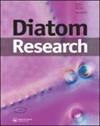来自西藏的新的有趣的硅藻。二、两新种广场形硅藻的记述
IF 1.3
3区 生物学
Q2 MARINE & FRESHWATER BIOLOGY
引用次数: 0
摘要
利用光学(LM)和扫描电子显微镜(SEM)观察描述了淡水广场花属Crenotia Wojtal的两个新种。两个物种,Crenotia distincta,sp.nov.和Crenotia oblonga,sp.nova.都具有独特的条纹结构,双到多变量终止于轴区附近。在内部,这些末端乳晕有C形开口,被一个逐渐变细的瓣片堵住,这是中国Crenotia物种特有的特征。在LM(大小和瓣膜轮廓)和SEM条纹结构上,这两个物种很容易相互区分,也很容易与该属的其他成员区分开来。条纹的双至多变量性质表明该属与Planothidium有亲缘关系,但在确定该属的系统发育位置之前,还需要进一步的系统发育分析。Crenotia的已核实记录目前在欧洲和亚洲已知,尽管Wojtal所属的物种也在北非和北美有报道。该属最初是从春天开始描述的,但似乎有更广泛的生态分布。本文章由计算机程序翻译,如有差异,请以英文原文为准。
New and interesting diatoms from Tibet. II. Description of two new species of monoraphid diatoms
Light (LM) and scanning electron microscopy (SEM) observations were used to describe two new species of the freshwater monoraphid genus Crenotia Wojtal. Both species, Crenotia distincta, sp. nov. and Crenotia oblonga, sp. nov. have a unique stria structure, bi- to multiseriate terminating near the axial area. Internally, these terminal areolae have C-shaped openings that are occluded by a tapering flap, a feature unique to Crenotia species in China. The two species are easily distinguished from each other and from other members of the genus in both LM (size and valve outline) and SEM stria structure. The bi- to multiseriate nature of the striae suggests an affinity of this genus with Planothidium, but further phylogenetic analyses are required before the phylogenetic position of this genus is settled. Verified records of Crenotia are currently known from Europe and Asia, although species included in the genus by Wojtal have also been reported from North Africa and North America. The genus was originally described from springs but seems to have a wider ecological distribution.
求助全文
通过发布文献求助,成功后即可免费获取论文全文。
去求助
来源期刊

Diatom Research
生物-海洋与淡水生物学
CiteScore
2.70
自引率
16.70%
发文量
27
审稿时长
>12 weeks
期刊介绍:
Diatom Research is the journal of the International Society for Diatom Research. The journal is published quarterly, in March, June, September and December, and welcomes manuscripts on any aspect of diatom biology.
In addition to full-length papers, short notes and reviews of recent literature are published which need not contain all the sections required for full-length papers; we see these as being necessary to record information which is of interest but which cannot be followed up in detail. Discursive “Opinion” papers are encouraged which would not necessarily follow the normal lay-out. If extremely long papers are to be offered, the author(s) should contact the editors first to discuss any problems. Book reviews, obituaries and meeting reports can be published. All papers will be subject to critical review by the editors and referees, as appropriate to their content. Papers will be accepted in English only.
 求助内容:
求助内容: 应助结果提醒方式:
应助结果提醒方式:


